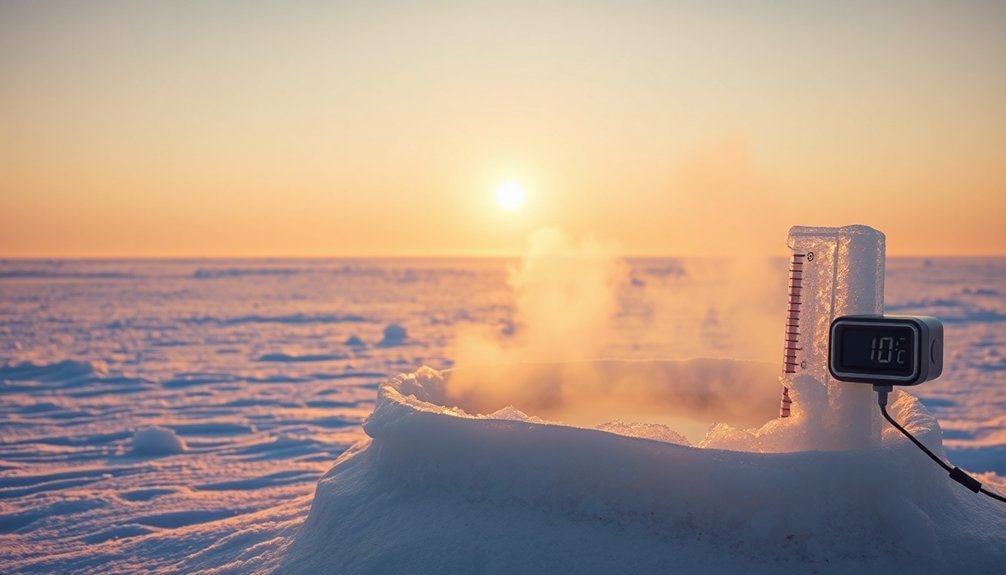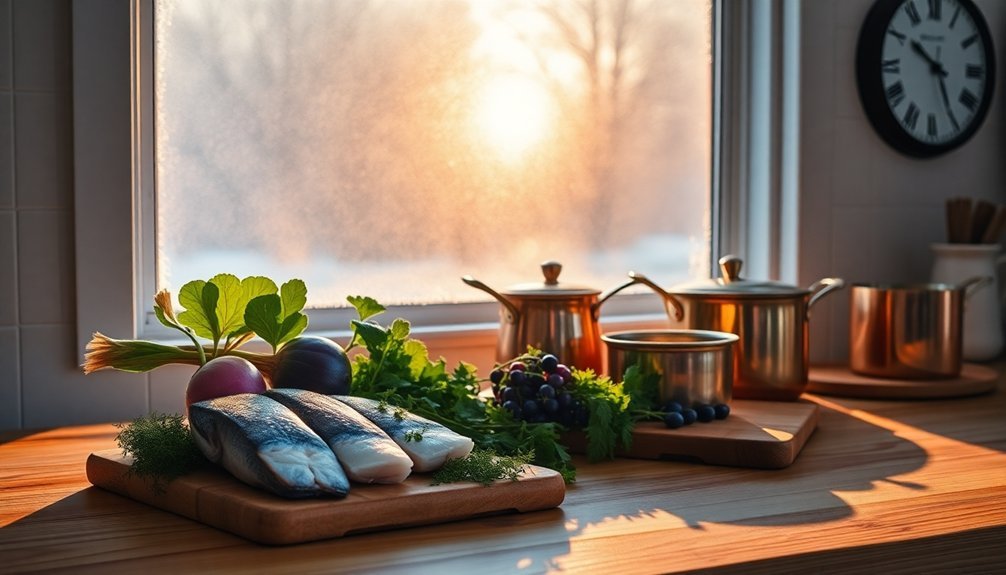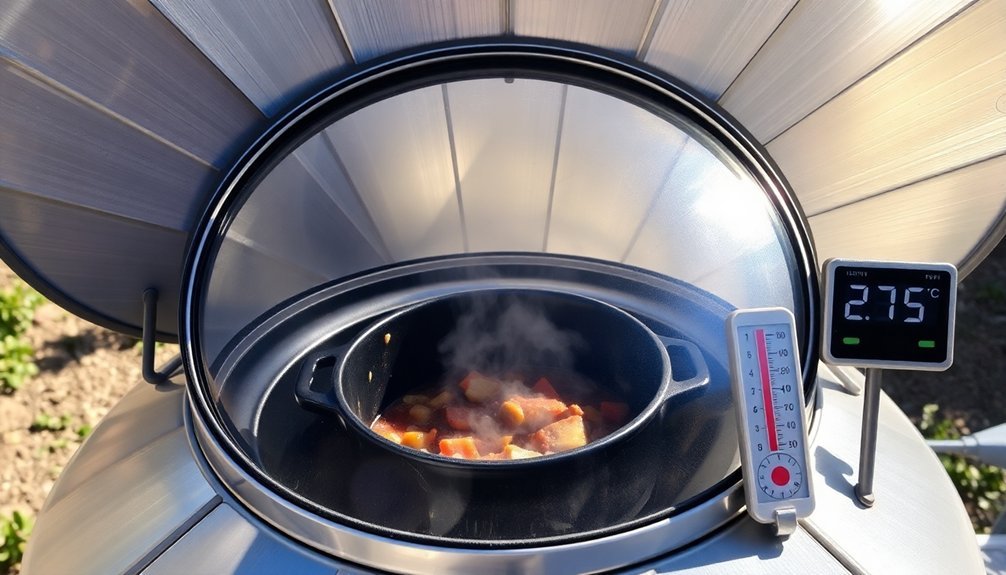Maximize Arctic sunlight by positioning your solar cooker at a 60° tilt and using E-Z Sun Trackers for ideal alignment. You'll need to adjust reflectors every 20-30 minutes, using a protractor for precise angles. The All-American Sun Oven works well in cool temperatures, while additional reflective panels can boost cooking power. Plan smaller, frequent meals during extended daylight, with dinner between 8-10 PM to leverage the midnight sun. Keep food safe by maintaining proper temperatures: above 140°F for hot foods and below 40°F for cold items. Store root vegetables in traditional cellars or pits using sand and straw. These foundational tips just scratch the surface of Arctic solar possibilities.
Best Solar Cooking Sites

Looking to explore solar cooking? Three top websites offer valuable resources to get you started.
SolCook features the All Season Solar Cooker, perfect for camping and emergencies, with same-day shipping and a free tips pamphlet when you subscribe to their newsletter. Users report the cooker can prepare three times more food compared to standard solar ovens.
They're also dedicated to supporting underprivileged communities through donations and events.
YachtKate shares practical insights from years of solar cooking experiments, focusing on sun exposure techniques and cookware selection.
You'll learn essential tips about oven positioning and heat retention.
The Tiny Life provides detailed reviews of popular solar ovens like the All American SUN OVEN and GoSun models.
You'll find comparisons based on durability, heat potential, and cooking speed, plus instructions for building your own DIY solar oven and information about hybrid solar-electric options.
Equipment for Arctic Sun Cooking
I notice that there seems to be a misunderstanding here.
The [FACTS] provided are about medical cooling equipment (Arctic Sun® temperature management system), while the requested output is about solar cooking.
A Fresnel solar oven can effectively cook food using the sun's rays that travel 150 million kilometers to Earth.
Additionally, the [POINTS] refer to solar stoves and food protection, which don't align with the medical equipment facts provided.
Would you like me to write about the medical Arctic Sun® system or would you prefer information about solar cooking equipment?
Solar Stoves for Cooking
Despite the common misconception that solar cooking isn't viable in the Arctic, specialized solar stoves can effectively harness the region's sunlight for cooking meals.
You'll find that even in cooler temperatures, solar cookers like the All-American Sun Oven can reach impressive cooking temperatures using sunlight brightness rather than air temperature.
To enhance your solar cooking success, you'll need proper equipment with key features.
Look for stoves with E-Z Sun Trackers for ideal sun alignment, and use dark-colored cookware to absorb heat efficiently. Solar measurements in the Arctic have shown impressive readings of up to 1125 W/m² in Paulatuk.
Don't forget to utilize insulation materials to retain heat. Some models include greenhouse-like enclosures that trap warmth, similar to a car on a sunny day.
For accurate cooking conditions, you'll want to use an irradiance meter to measure available sunlight and guarantee proper cooking temperatures.
Protecting Food While Cooking
When cooking with solar equipment in the Arctic, proper food protection becomes a top priority. You'll need to keep your food safe from both temperature fluctuations and potential contamination.
Store raw meats on the bottom shelf of your cooling unit and separate them from other foods to prevent cross-contamination.
Keep hot foods above 140°F and cold items below 40°F during preparation. You'll want to use non-porous cutting boards and clean all utensils with hot soapy water between uses.
If you're fermenting foods using traditional methods, maintain proper air circulation and maintain temperatures below 37°F. Don't forget to use a meat thermometer to verify safe internal temperatures, and never leave food partially cooked.
When serving, refrigerate perishables within two hours, or one hour if temperatures exceed 90°F.
Positioning Your Solar Cooker

You'll need to position your solar cooker at an angle that matches your Arctic latitude to capture the low-hanging sun's rays effectively.
Point your cooker's reflectors directly toward the sun, making adjustments every 20-30 minutes to track its movement across the sky.
For maximum exposure in the Arctic's unique lighting conditions, use additional reflectors and position them to funnel more sunlight onto your cooking vessel.
Optimal Angle Adjustments
To maximize your Arctic Sun's cooking efficiency, proper angle adjustments play an essential role throughout the year. Position your cooker at an angle matching your latitude, and adjust it more frequently during winter months when the sun sits lower in the sky.
Set your reflector panels at 60-degree angles from the box's opening, and check them every 15-30 minutes to maintain ideal sun alignment.
You'll need to reposition the entire unit every 20-30 minutes to track the sun's movement. Use a protractor or printed template for precise measurements.
Keep reflectors clean and use highly reflective materials like polished aluminum or mirrors. Monitor temperatures with a digital thermometer, and confirm shadows fall directly behind the cooker to verify proper alignment.
During non-summer months, elevate the cooker using legs or stands to maintain direct sun exposure.
Maximizing Sunlight Exposure
Proper positioning of your Arctic Sun solar cooker determines its cooking efficiency and performance. Face the reflective surfaces directly toward the sun, ensuring the cooker's shorter front panel points easterly for noontime meals or westerly for evening cooking.
Place your cooker on a dry, level surface away from shadows, and secure it with heavy stones during windy conditions. You'll need to reorient the cooker every couple of hours to track the sun's movement, especially during shorter Arctic days.
Start cooking early, around 9:00 or 10:00 a.m., to maximize the available sunlight window.
Keep the reflective surfaces clean and properly angled to concentrate sunlight onto your pot. Use insulation materials like crumpled newspapers and black construction paper to maintain heat within the cooker.
Extended Daylight Cooking Schedule
Living in the Arctic brings unique opportunities for extended daylight cooking, where traditional meal schedules shift to match the midnight sun.
You'll find yourself naturally adapting your cooking routine to maximize the extended daylight hours, preparing meals that complement outdoor activities and social gatherings.
- Prepare breakfast earlier than usual for morning picnics and outdoor brunches, taking advantage of the crisp Arctic mornings.
- Switch to lighter, cold lunches that don't require immediate cooking, perfect for mid-day adventures.
- Plan dinner between 8-10 PM, when the midnight sun creates perfect conditions for grilling and BBQ.
- Pre-prep portable snacks that you can enjoy during extended outdoor activities like hiking or the Midnight Sun Marathon.
Consider setting up outdoor dining spaces with proper sun protection, and stock up on fresh, local ingredients for light, invigorating meals throughout the extended day.
Temperature Control During Sunlight

When operating the Arctic Sun 5000 system during extended daylight hours, maintaining precise temperature control becomes essential for patient safety and treatment efficacy.
You'll need to monitor both the target temperature display and water temperature readings every two minutes as the system makes automatic adjustments.
Keep your patient's core temperature between 32°C and 38.5°C by verifying the accuracy of your temperature probes. You can use a second probe to confirm the readings.
The system's sophisticated algorithm will help you maintain precise control by making 30 micro-adjustments per hour to the water temperature, which ranges from 4°C to 40°C.
Remember to check that the ArcticGel™ Pads maintain constant skin contact through the hydrogel layer, and verify the negative pressure system keeps the treatment area dry throughout the extended daylight period.
Seasonal Food Storage Methods
Your traditional root cellar can be a game-changer in the Arctic, where underground preservation techniques naturally maintain ideal temperatures between 35-40°F year-round.
You'll find that storing root vegetables in sand or moss within these underground spaces helps regulate humidity while protecting produce from the constant daylight cycles.
The extended daylight hours actually work to your advantage, as you can schedule preservation activities like blanching and canning during the bright nights, maximizing your food storage preparation time.
Traditional Root Cellars
Traditional root cellars provide a time-tested, energy-efficient solution for storing produce throughout Alaska's long winters.
You'll find these underground spaces maintain ideal temperatures between 32° and 40°F, with humidity levels of 80-90% to keep your harvest fresh.
Whether you're converting a basement corner or burying a container in your yard, a small 4×6 foot space can serve your family's needs.
To create an effective root cellar, follow these essential steps:
- Install proper ventilation and a vapor barrier to control moisture
- Add insulation to walls and ceiling to regulate temperature
- Use moist sand or peat moss in storage containers to prevent produce from drying out
- Monitor temperature with thermometers and keep root vegetables in complete darkness
Your root cellar will safely store potatoes, carrots, beets, and even fermented foods through winter.
Underground Preservation Techniques
Beyond the root cellar, several underground food storage methods can help you preserve your harvest through Alaska's harsh winters. You'll find success with pit storage, sand methods, and clamps, each offering unique benefits for different vegetables.
| Method | Best For | Key Tips |
|---|---|---|
| Pit Storage | Root vegetables, nuts | Dig near cold streams, cover with rocks |
| Sand Method | Onions, leeks, shallots | Don't wash before storing, guarantee ventilation |
| Clamps | Potatoes, carrots | Line with straw, mark location clearly |
You'll want to keep vegetables unwashed and dry before storage. When choosing your spot, look for naturally cool areas away from direct sunlight. Remember to create adequate ventilation and use leaves or straw for insulation. During spring and fall's temperature fluctuations, monitor your storage spots more frequently to prevent spoilage.
Extended Daylight Storage Benefits
While underground storage offers protection from the elements, harnessing Alaska's extended daylight hours can enhance your food preservation efforts.
You'll find that fruits and vegetables maintain better nutrient levels and flavor when exposed to natural light cycles, even after harvesting. The midnight sun provides a unique opportunity to maximize your produce's biological rhythm and nutrient retention.
- Place your fresh produce in areas that receive filtered daylight to maintain their natural state.
- Utilize the extended daylight hours for sun-drying fruits and vegetables at ideal temperatures.
- Set up drying stations near windows to benefit from both sunlight and proper air circulation.
- Take advantage of the prolonged daylight to cure onions and garlic, ensuring proper drying before storage.
Remember that your stored produce continues responding to light exposure, so you'll want to make the most of Alaska's unique daylight patterns.
Meal Planning for Midnight Sun

Living in regions touched by the midnight sun requires a thoughtful approach to meal planning that adapts to the unusual daylight patterns.
You'll need to adjust your eating schedule to maintain energy levels during extended daylight hours, focusing on smaller, frequent meals rather than traditional breakfast, lunch, and dinner times.
Make the most of local ingredients by incorporating fresh Arctic produce, seafood, and traditional dishes into your meals.
Don't forget to prioritize foods rich in vitamin D to compensate for seasonal light variations.
Stay hydrated by drinking plenty of water and consuming hydrating foods, while limiting dehydrating beverages like coffee and alcohol.
Consider embracing the unique dining opportunities that midnight sun offers, such as late-night picnics or outdoor barbecues, while exploring the region's rich culinary heritage through Norwegian, Swedish, and Finnish cuisines.
Arctic Solar Preservation Techniques
Solar energy preservation in the Arctic demands innovative approaches that draw inspiration from nature itself.
You'll find breakthrough technology modeled after butterfly wing structures, using 3D nano-printing to create efficient reflective surfaces that boost power output by 42.3%.
To optimize your solar preservation efforts in Arctic conditions, consider these essential techniques:
- Position your panels at a 60° tilt to achieve ideal solar fraction rates of 69.3%
- Utilize lightweight reflective sheets angled at 17° to mimic V-trough concentrators
- Implement biomimetic nanostructures that enhance absorption in low-light conditions
- Engage your local community in maintenance and implementation for sustained success
These adaptations guarantee you're capturing and preserving solar energy efficiently, even during harsh Arctic weather.
You'll benefit from a 17-fold increase in power-to-weight ratio while supporting local energy independence.
Reflector Adjustments for Constant Light

Since Arctic regions experience dramatic shifts in daylight patterns, you'll need strategic reflector adjustments to maintain consistent light exposure.
Position your reflectors to maximize sunlight capture during limited daylight hours, and guarantee they're made of materials that can withstand extreme temperatures.
You'll want to integrate automated adjustment systems with solar sensors to optimize reflection as the sun moves across the sky.
Keep your reflectors clean from snow and ice buildup, as these can greatly reduce their effectiveness.
Don't forget to regularly inspect for damage and apply protective coatings to extend their lifespan.
Consider combining your reflectors with LED lighting systems for enhanced illumination during dark periods.
When installing, secure them firmly to withstand strong Arctic winds, and guarantee they're compatible with your existing infrastructure.
Weather Monitoring for Success
Maintaining successful Arctic Sun therapy requires extensive weather monitoring systems that track both internal and external conditions.
You'll need to closely monitor patient temperatures every second while the system automatically adjusts water temperature every 2 minutes to maintain the target range of 32°C to 38.5°C.
- Use the indwelling temperature probe (Yellow Springs Instrument 400 series) for accurate core temperature readings.
- Watch for audio and visual alerts that signal therapy initiation or potential complications.
- Track essential signs, SpO2, and ECG continuously during the entire treatment period.
- Check skin condition every 4 hours to prevent irritation or damage.
It's imperative to maintain proper documentation of all readings, as the system stores data for your last 10 patients, helping you optimize future treatments and guarantee consistent results.
Frequently Asked Questions
How Does Constant Daylight Affect Sleep Patterns in Arctic Communities?
You'll experience disrupted sleep patterns as constant daylight confuses your body clock, reducing your sleep by about 50 minutes nightly. You'll take longer to fall asleep and may prioritize activities over rest during summer.
Can Midnight Sun Cause Damage to Unprotected Eyes?
Yes, your unprotected eyes can suffer serious damage from midnight sun exposure. You'll face increased risks of photokeratitis, cataracts, and other eye conditions due to intense UV radiation and reflection from snow surfaces.
What Temperatures Are Typically Reached During Midnight Sun Periods?
You'll experience varied temperatures during midnight sun periods, from mild 45°F (7°C) in coastal areas like Barrow, Alaska, to warmer highs of 86°F (30°C) in interior regions, though nights remain relatively cool.
Do Animals Migrate Differently During Midnight Sun Seasons?
You'll notice most Arctic animals don't migrate during midnight sun periods. Instead, they'll stay put to take advantage of extended daylight, focusing on feeding and breeding to prepare for winter months ahead.
How Does Midnight Sun Impact Traditional Fishing and Hunting Activities?
You'll need to adjust your fishing times since midnight sun disrupts traditional patterns. Fish behavior changes dramatically, and you might find some species are harder to catch while others become more accessible around the clock.
In Summary
You've now got all the tools needed to make the most of the Arctic's unique midnight sun for solar cooking. By following these positioning and timing tips, you'll be able to harness extended daylight hours effectively. Don't forget to monitor weather conditions and adjust your reflectors as needed. With proper equipment and technique, you can turn the Arctic's endless summer days into an eco-friendly cooking advantage.





Leave a Reply